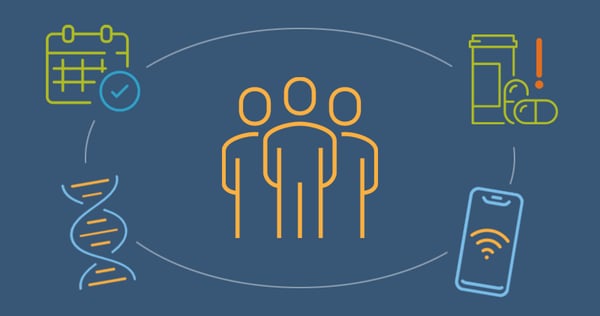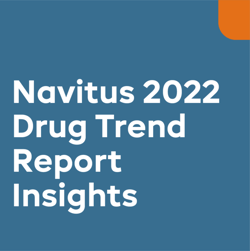Plans can leverage population health management programs to achieve better health outcomes. Learn a few best practices in today’s blog.

During a recent World Congress webinar, Navitus’ Dr. Julie Olson, Vice President of Clinical Innovation and Dr. Marnie Wickizer, Associate Director of Population Health & Residency Program Director, discuss how population health management programs can support plan sponsors’ goals to improve outcomes and deliver meaningful cost savings.
Missed the webinar? Don’t worry – here’s a recap of what you need to know.
At its core, a pharmacy benefit managers (PBM’s) population health management strategy should include programs that:
- Are based on evidence
- Provide actionable information
- Compliment the plan’s benefit philosophy
- Use nationally validated quality indicators
- Include documented and auditable outcomes
- Offer a comprehensive approach to managing high-cost drugs
Here’s a high-level overview of a few population health management programs and how they can support plan sponsors’ goals and benefit philosophy.
PHARMACOADHERENCE
Only 50% of Americans take their medications as prescribed, leading to adverse effects and increased health care costs.1,2 Pharmacoadherence programs identify non-adherent members taking their medication as prescribed less than 80% of the time. Intervention letters are sent to the member and/or the prescriber, thereby improving care coordination and increasing member education of their condition and medication.
While this program can be applied to any chronic condition, the most common disease states include cholesterol, diabetes, hypertension, depression, rheumatoid arthritis and attention deficit hyperactivity disorder (ADHD).
RESULTS: In 2020, 30% of intervened members improved to a proportion of days covered (PDC) of at least 0.80.3 Evidence suggests that for many chronic illnesses, increased medication adherence reduces hospitalization and medical costs, and provides a positive return on investment (ROI).4
OPIOID SAFETY SOLUTIONS
Opioid overutilization is a serious nationwide epidemic, resulting in misuse, overdoses and deaths. An estimated 20% of Americans suffer from chronic pain,5 and over 191 million opioid prescriptions are dispensed each year.6 A comprehensive suite of opioid safety solutions can help plan sponsors combat abuse and misuse among their members.
Proactive methods, such as Concurrent Drug Utilization Review (CDUR) programs offer many ways to alert pharmacies to potential opioid abuse at the point of sale. Additionally, a consultative and collaborative approach to formulary development and management may include preferring abuse-deterrent opioids on the formulary or implementing quantity limits on specific drug products.
At Navitus, we are doing our part to help prevent prescription opioid misuse and abuse with our suite of opioid safety solutions, including the recent launch of Predictive Analytics for the Misuse of Opioids (PAMO).
Retrospective methods, such as Retrospective Drug Utilization Review (RDUR) programs perform a retrospective claims review based on set criteria, seeking patterns of medication use that are potentially unsafe, inappropriate or ineffective, thereby reducing adverse drug effects and encouraging coordinated care across the health care team.
RESULTS: In 2020, 34% of members that were identified by Navitus’ RDUR Safety-Focused Program improved, and would no longer requalify for the program.3
pharmacogenomics (pgx)
Pharmacogenomics is the study of how genes affect an individual’s response to particular medications. Pharmacogenomics, or PGx, can help optimize medication therapy, reduce high health care costs and decrease hospitalizations.
RESULTS: Researchers have seen 40% fewer emergency visits and 58% fewer hospitalizations in depression and anxiety patients that participated in PGx testing, compared to patients who did not test.7
In a recent Navitus research study, 76% of members that tested received at least one PGx recommendation.3 The most common medications with medication adjustment recommendations were anti-depressants, anti-hyperlipidemics for cholesterol and proton pump inhibitors (PPIs).
dIGITAL THERAPEUTICS
Digital therapeutics is a subset of digital health that uses software, apps or other digital technology to manage or treat chronic conditions by changing member behavior.
During the pandemic, digital therapeutics and telehealth offerings have grown significantly. Early data shows members are engaging with digital therapeutics solutions at all hours, not just typical clinic hours, which is meeting a demand different from anything the health care system has seen before. In many cases, digital therapeutics can reduce the reliance on pharmaceuticals and/or hospitalization, and allow members to take ownership over their health care journey. Plus, many of these solutions offer an educational component, which is helping improve health literacy among members.
fOLLOWING BEST PRACTICES
While these programs are only a small snapshot into the wealth of population health management programs available and the benefits they provide, here are a few questions to consider as you are evaluating programs for your own population.
- How are members identified?
- What controls are in place to prevent medication abuse and misuse?
- What is the success rate for population health programs?
- How are adherence and waste evaluated?
- What channels of engagement are available?
Have more questions? Email us at sales@navitus.com or contact your account team today to learn more!
- Why You Need to Take Your Medications as Prescribed or Instructed. FDA. https://www.fda.gov/drugs/special-features/why-you-need-take-your-medications-prescribed-or-instructed#:~:text=The%20High%20Cost%20of%20Not,per%20year%20in%20this%20country. Published February 16, 2016. Accessed December 8, 2021.
- Aungst, T. Does Nonadherence Really Cost the Health Care System $300 Billion Annually? Pharmacy Times. https://www.pharmacytimes.com/view/does-nonadherence-really-cost-the-health-care-system-300-billion-annually. Published June 1, 2018. Accessed June 6, 2020.
- Navitus Internal Data, 2020.
- Sokol, McGuigan, K. A., Verbrugge, R. R., & Epstein, R. S. Impact of Medication Adherence on Hospitalization Risk and Healthcare Cost. Medical Care. https://journals.lww.com/lww-medicalcare/Abstract/2005/06000/Impact_of_Medication_Adherence_on_Hospitalization.2.aspx. Published June 2005. Accessed December 8, 2021.
- Dahlhamer J, Lucas J, Zelaya, C, et al. Prevalence of Chronic Pain and High-Impact Chronic Pain Among Adults —United States, 2016. Centers for Disease Control and Prevention – Morbidity and Mortality Weekly Report. https://www.cdc.gov/mmwr/volumes/67/wr/mm6736a2.htm. Published September 14, 2018. Accessed January 18, 2019.
- Centers for Disease control and Prevention. Annual Surveillance Report of Drug-Related Risks and Outcomes. https://www.cdc.gov/drugoverdose/pdf/pubs/2018-cdc-drug-surveillance-report.pdf. Published August 31, 2018. Accessed January 18, 2019.
- Perlis RH, Mehta R, Edwards AM, Tiwari A, Imbens GW. Pharmacogenetic testing among patients with mood and anxiety disorders is associated with decreased utilization and cost: A propensity-score matched study. Depress Anxiety. https://pubmed.ncbi.nlm.nih.gov/29734486/. Published May 7, 2018. Accessed December 9, 2021.




